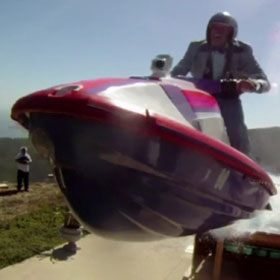Jackass 3D

3/5
Perhaps the most striking characteristic of the Jackass films is the complete inversion of values they represent: a stunt is not considered a success unless it is a complete failure resulting in some hilarious injury; a prank is not considered a success unless it fails and someone is humiliated or forced to vomit; instead of being suppressed by the editors, blooper footage, such as that depicting the tormented performers experiencing what can only be described as emotional breakdowns in response to the pressure to perform the stunts, is left in the final cut.
While, superficially, Jackass 3D, finds Johnny Knoxville and company in something of a holding pattern, it does feature a few of the most dangerous stunts they've ever attempted. But are they really the most dangerous, the most reckless and potentially lethal and not, in fact, the most refined and most controlled crowning achievements of a body of work ten years in the making? A great deal of the Jackass collective's appeal—and, for that matter, the appeal of stunt performance in general—relates directly to the threat of injury and possible death implicit in the spectacles. But at this late point in Jackass history, it has become more and more difficult for fans to accept that they are witnessing anything but the most scrupulously planned, rehearsed and staged stunts of highly trained professionals.
Of course, there is a certain inevitable excitement when Johnny Knoxville rides a personal watercraft through a swimming pool and up a slide which hurls him through the air then through a hedge and down a hill before landing in a vertical position, but at no point does the viewer feel that the man is any real danger. As he’s already proved himself to be impervious to death or serious injury—either due to his training or the fact that he is completely insane—the point is largely moot. When Knoxville, in the guise of his geriatric alter ego, Irving Zissman, rides a motorcycle through the plate glass window of a car dealership and takes off down the street leaving employees and bystanders rubbing their heads, you may cringe at the stunt and then laugh uproariously as its absurdity, but you might also wonder who left the keys in the ignition, why the employees didn’t realize they were being filmed and why he would be allowed to carry out such a reckless and obviously illegal stunt. You might even draw the incredibly deflating conclusion that this was a staged event.
Jackass may even be aware that they are no longer of interest to the viewing public as death-defiers, as Jackass 3D finds them forgoing the more conventional stunts of the past in favor of a series of coprophilic jokes. The content of these sequences transcends any sort of critical evaluation and should probably be submitted for the immediate review of a mental health professional, but from the film’s outset, it becomes apparent that the dick and fart humor of Jackass 3D is a far less innovative than that of the previous installment: the standard against which all work in this medium must be judged. While Jackass: Number Two boasted not only the infamous “Butt Chug” but what is probably the greatest and undoubtedly the most horrifying of all Jackass routines, “The Fart Mask,” Jackass 3D devotes an entire sequence to an unidentified man sneaking up to his friends and urinating on them: a scene for which the director of photography makes use of what can only be described as an "over the penis"-shot.
The stereoscopic cinematography lends nothing to the festivities other than the occasional sight gag, the troupe’s treatment of animals is far from ethically sound and their attempts at shtick tend to fall flat, but all in all, the film is a success. Any further expatiation of its contents will surely spoil the fun for those who have yet to see it, but rest assured that, as is always the case, the film’s centerpiece features some combination of Steve-O, human feces and bungee cable.
RELATED ARTICLES
Get the most-revealing celebrity conversations with the uInterview podcast!







Leave a comment